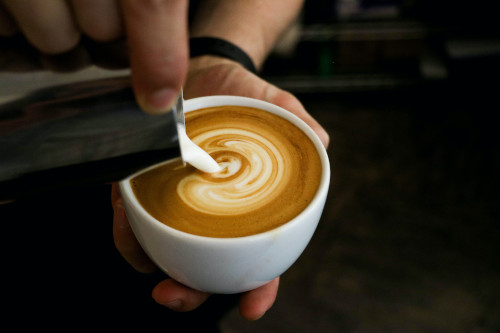You look at the coffee shop menu and see a long list of coffees: Americano, latte, cappuccino, flat white, mocha, and the list goes on. They all have different names and prices, and people are confidently ordering their coffee of choice.
All of these coffees must be different. But how exactly?! And how do you know which type of coffee you will like best?
If this situation sounds familiar, don’t worry! Most people have been confused by coffee options at some point. (And that’s before you even get to the strange names for different sizes of coffees that some chains insist on using!)
At Brewing Coffees, we offer straightforward comparisons that help you to understand the difference between types of coffee drinks.
Today, we’re going to compare the cappuccino and the flat white. What’s the difference? Let’s find out!
The Difference Between a Cappuccino and a Flat White
Cappuccinos and flat whites are similar. Both drinks include one or two shots of espresso combined with steamed milk and a layer of foamed milk.
The difference between a cappuccino and a flat white is that the top layer of milk foam is thinner in a flat white than it is in a cappuccino.
In a cappuccino, one-third of the drink is espresso, one-third is steamed milk, and one-third is milk foam. A flat white is similar, but the foam layer isn’t anywhere close to one-third of the coffee.
Cappuccino foam is thicker and much denser than the foam you will find on a flat white, and the cappuccino foam will have much larger and more noticeable bubbles.
Because a flat white’s layer of foam is thinner and lighter, with smaller bubbles, it is smoother to taste and usually has a shinier, glossier appearance than a cappuccino foam.
The thinner foam layer on a flat white also means that any foam art can be more complex. This is because the foam on top of the drink is smoother, which allows the barista to “draw” finer lines and therefore create more intricate designs.
Another difference between a cappuccino and a flat white is that flat whites are usually only available in a single size – around 6oz. This differs from cappuccinos, which coffee shops usually sell in various sizes.
Because they are only served in a small size but contain the same amount of espresso, flat whites usually have a stronger, bolder flavor than cappuccinos.
How to Steam Milk for a Cappuccino
To steam milk for a cappuccino, you will need a milk jug and a steaming wand.
First, add milk to your jug until it is around half full.
Next, place the steaming wand into the milk so it is submerged just below the surface of the milk.
Switch on the steaming wand and slowly move it around to increase the volume of milk.
Because the milk will start to froth up – increasing in volume – you will need to gradually lower the milk jug as you steam to keep the wand close to the milk’s surface.
The milk is ready when its temperature reaches 65C (149F).
Finally, give the jug a firm tap on the table to get rid of the largest bubbles, then swirl the jug gently to make the milk smooth and shiny.
Your steamed milk is then ready to pour onto your espresso, followed by a layer of milk foam.
How to Steam Milk for a Flat White
To steam milk for a flat white, half-fill a jug with milk, then insert the steaming wand just below the milk’s surface.
Tilt the jug and switch on the steaming wand. The jug must remain tilted, creating a “whirlpool effect” that will turn your milk into a smooth micro-foam.
Don’t steam the milk for too long. The milk you use in your flat white should be less thick and foamy than the froth you use in a cappuccino. It may only take a few seconds of steaming to achieve the perfect micro-foam texture.
Next, remove the steaming wand and tap the jug on a hard surface. Then swirl the milk gently until it looks like smooth white gloss paint.
It’s now time to pour your flat white. Pour the milk onto the espresso from a few inches above the cup with the coffee held at a slight angle. Stop when the cup is about three-quarters full.
Finally, bring the milk jug spout right down to the level of the cup and, while still holding it at an angle, pour the rest of the milk until the coffee is level with the top of the cup. With practice, you’ll be able to create some beautiful patterns in your flat white foam.
Are Flat Whites made with Ristretto rather than Espresso?
Another commonly quoted (though not entirely true!) difference between the cappuccino and the flat white is that cappuccinos are made using espresso, whereas flat whites are made with a ristretto shot.
Ristretto is a more concentrated version of the espresso shot. It is made using the same amount of ground coffee as espresso but with only half the amount of water.
Even though the two shots contain the same amount of coffee, the smaller quantity of water in the ristretto gives it a bolder, stronger flavor.
Alan Preston, an Australian who claims to have created the first Flat White (though it’s debatable whether the drink has its origins in Australia or New Zealand, as others also claim to have made it first), used a double ristretto shot in his flat whites.
However, this does not mean that all ‘proper’ flat whites must be made with ristretto. It’s common to find flat whites made with espresso, and either type of shot is perfectly acceptable.
Some coffee shops use espresso while others use ristretto, and if you’re making the flat white at home, then it’s purely a matter of personal preference.
FAQs – Cappuccino vs Flat White
Some might argue that a flat white tastes like a “light” cappuccino. This is due to the different ratio of steamed milk. A flat white contains more steamed milk than a cappuccino.
Yes, as the cappuccino has a 1:1 ratio of coffee to steamed milk, as opposed to a 1:3 ratio in a flat white, the cappuccino is noticeable stronger than the flat white.
That really depends on what type of milk you use as the flat white contains more steamed milk than a cappuccino. The sweetness (or sweeter taste) is likely to arise from the fact that a flat white has a 1:3 ratio of steamed milk instead of 1:1 ratio for the cappuccino.

I’m Joel, an espresso-loving coffee nerd. I got into coffee because I spent a lot of time in Milan as a kid and started liking coffee waaaay too young. I’m all about making sure espresso is treated with the same care as any other coffee – it’s not just a quick drink!


Leave a Reply